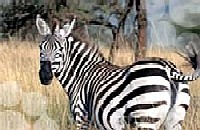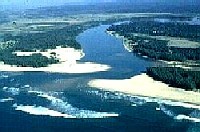The phrase Big Five Game was coined by game hunters and refers to the five large mammals that were originally most sought in Africa. The term is still used in most tourist and wildlife guides that discuss African wildlife.
The collection consists of the lion, elephant, buffalo, leopard and rhinoceros. The members of the big five were chosen for the difficulty in hunting them and not their size, which is why the leopard is on the list and the enormous hippopotamus (noted for lazing around in pools and rivers all day) is absent.
The male lion, easily recognized by his mane, may weigh up to 250 kg (550 lb). Females are much smaller, weighing up to 136 kg (300 lb). In the wild lions live for around 10–14 years, while in captivity they can live over 20. Lions are predatory carnivores who live in family groups, called prides. The family consists of related females, their cubs of both sexes, and one or more unrelated males who mate with the adult females.
Although it was once thought that females did most of the hunting in the pride, it is now known that males contribute much more to hunting than the amount for which they had been previously given credit. Both males and females will defend the pride against outside intruders. Typically, males will not tolerate outside males, and females will not tolerate outside females. Males are expelled from the pride or leave on their own when they reach maturity. When or if a male coalition takes over a pride and ousts the previous coalition, the conquerors often kill any cubs that they did not father.
Like all other cats, lions are superpredators, but unlike all other cats they are social hunters and take prey too large and dangerous to overpower singly, including adult zebras, cape buffalo, giraffes, hippopotamuses, and even sub-adult elephants. Singly, a lion kills with the neck bite that breaks the neck or severs vital blood vessels; several lions may pin a large prey animal while another delivers the lethal neck bite or suffocates the prey by covering the victim's muzzle, preventing breathing. Lions are not averse to scavenging, and they frequently drive off smaller or outnumbered predators from kills and take the prey. Lions too can be driven off from prey by such competitors as hyenas and wild dogs in overwhelming numbers. Like other cats they have superb night vision that makes them more effective at night. They can sleep as many as 20 hours in a day.
Although it was once thought that lionesses did the bulk of the hunting and killing, it is now known that male lions contribute far more than they were originally given credit for. As a rule, all of the females of a pride are related (grandmothers, aunts, mothers, sisters). Both males and females defend the pride.
African Elephants have a thick, almost hairless skin, a long, flexible, prehensile trunk, upper incisors forming long curved tusks of ivory, and large fan-shaped ears.
Elephants are herbivores, spending 16 hours a day collecting plant food. Their diet is at least 50% grasses, supplemented with leaves, twigs, bark, roots, and small amounts of fruits, seeds and flowers. Because elephants only use 40% of what they eat they have to make up for their digestive system's lack of efficiency in volume. An adult elephant can consume 300 to 600 pounds (140 to 270 kg) of food a day. 60% of that food leaves the elephant's body undigested.
In the wild, elephants exhibit complex social behavior and strong familial bonds. Most females will live in family groups with up to 200 mothers, daughters and sisters. Males, on the other hand, are commonly found living alone or in smaller ( up to 20) temporary bachelor groups. Social hierarchy in calf-cow groups is based on size and age, with the largest and oldest at the top and the smallest and youngest coming in last. Adolescent males determine their own ranking order through jousting contests using head and tusks, where strength and temperament are as important as size and age. Generally, though, males are very tolerant of each other. The exception is when a female is in estrus. Bulls will roam from female group to group, staying with a specific female in estrus for a couple of days to ensure fertilization and will have no part in raising the calf. Females in estrus try not to court males, but usually choose a mate based on size and dominance, which tends to be a male in musth.
They communicate with very low and long-ranging subsonic tones.
Elephants, especially males, have been known to knock down trees and bushes when excited, socially pressured, or when looking for food.
These bovine animals are quite intimidating. They are the most dangerous of the "Big Five" game animals for hunters. They are definitely bovine characters, but also primal and with slightly mean appearance at times, despite the bouffant look of their horns.
The buffalo is up to 1.7 meters high, 3.4 meters long, and can reach a weight of 900 kilograms. The Cape Buffalo is a very powerful creature, demanding respect from even a pride of lions when paths cross. Other than man, they have few natural predators and are capable of defending themselves against (and sometimes killing) lions, who will attack only old, sick, or immature buffaloes. The leopard is a threat only to newborn calves. Crossbreeding with domestic cattle has had only limited success, and the African Buffalo remains a wild animal.
Known as one of the "big five" in Africa, the Cape Buffalo can be a volatile and formidable beast.
Cape Buffalo prefer areas of open pasture, close to jungle and swampy ground where they can wallow. They are found in Ethiopia, Somalia, Zimbabwe, Namibia, Botswana, Mozambique and South Africa, with a significant seasonal presence in Kenya and Tanzania.
The main herd consists of all sexes and ages, though bachelor groups are also found. A male is recognizable by the thickness of his horns, and is called the "Boss." Bulls mature at eight years of age. Cows first calve at five years of age, after a gestation period of 11.5 months.

